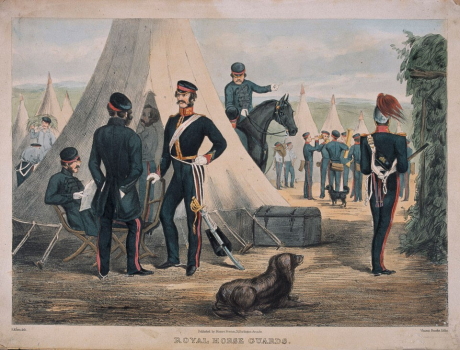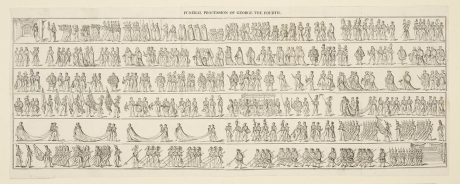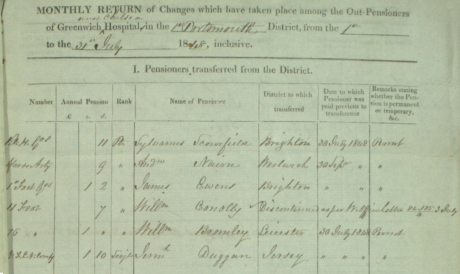2 Brunswick Street West, resident: Sylvanus Scourfield
Born: 1802; Narberth, Pembroke South Wales. (His father’s occupation is recorded as a farrier on Sylvanus’s wedding certificate). His first name is also spelt Silvanus.
Military career: On the 7th December 1824, at the age of 22, Sylvanus enlisted in the Royal Regiment of Horse Guards (The Blues) with the service number 211. He served, in the rank of private, with this regiment until his discharge due to chronic rheumatism in 1846 at the age of 44. His dates of service place him in the period between the Napoleonic and the Crimean wars, a period during which the Royal Horse Guards underwent a long period of home service that lasted from 1816 until 1882 when part of the regiment was deployed to Egypt. During this period of ‘home service’ they regularly undertook royal escort duties in London and Windsor and helped maintain public order in the southeast of England.

Royal Horse Guards 1853
In July 1830 the entire regiment escorted the funeral cortege for George IV to St George’s Chapel, Windsor.
‘The funeral procession set out at about half past eight to the sound of the King’s band playing “The Dead March in Saul”, with William IV as chief mourner, followed by his royal relatives, the Dukes of Sussex, Cumberland and Gloucester, and Prince Leopold. The Duke of Wellington bore the sword of state. The soldiers held flambeaux in the failing light which La Belle Assemblée noted “presented a striking yet a solemn effect.”’

Funeral procession of George IV in six bands across the sheet, with funeral car of George IV towards the centre
His service record states his duty location as London and Windsor and in the census of 1841 he is listed at the Hyde Park Barracks in London.
On 13 June 1846, Private Sylvanus Scourfield was discharged from the army due to chronic rheumatism. His conduct is described as being of a very good and efficient soldier with Four Rings and Distinguishing Marks for good conduct.

1846 army discharge papers
Sylvanus is recorded as being admitted as a permanent ‘Out Pensioner’ on 23rd June 1846 with an annual pension rate of 11d. Initially he is recorded as being in London but the ‘Monthly Return for changes which took place for out pensioners’ for the ‘period 1st to 31st July 1848’ he is recorded as transferring from ‘Greenwich and Chelsea Hospital in the 1st Portsmouth District’ to Brighton; Chelsea is handwritten next to Greenwich, so this is an adapted document with Sylvanus actually transferring from London.

Monthly Return for Out Pensioners from the 1st to 31st July 1848
Army pensions were introduced in 1689 during the reign of King William III and Queen Mary II. The pension was made available to all former soldiers who had been injured in service, or who had served for more than 20-years, as was the case for Sylvanus. The Royal Hospital Chelsea was unable to house the number of pensioners, therefore a system was developed where eligible ex-soldiers who could not be housed in the Hospital were termed Out-Pensioners, receiving their pension from the Royal Hospital but living outside it.
On 13th November 1845, whilst still a serving member of the regiment he married Martha Walton. The marriage certificate records his residence as Regents Park; Martha is recorded as resident in Southampton Buildings, London. In 1823, Dr Birkbeck founded the Mechanics’ Institution in Southampton Buildings, which later became the London Mechanics’ Institution, and was used as a theatre for delivering the lectures of the professors. The London Mechanics’ Institution, the forerunner of Birkbeck College, which is now a part of the University of London, was headquartered at Southampton Buildings until 1884. No occupation is listed for Martha, but it is probable that she was employed in domestic service at the time of her marriage. Martha was born in 1798 in Hampshire.
Brighton: Sylvanus and Martha are listed on the 1851 census as living at 2 Brunswick Street West. Sylvanus is recorded as an ‘out pensioner’, Martha has no occupation listed. Neither of them appears in any of the street directories for that period.
Sylvanus is recorded as dying at the age of 57 in 1853 whilst living in Hove. Martha appears in the 1861 census at 22 & 23 Montpelier Crescent and is listed as a cook; in the 1862 street directory this address is listed as a ‘Preparatory Gentlemen’s School’. She is recorded as dying in1864 at the age of 66. In her probate entry her address at the time of her death is given as 11 Upper-Market Street, Hove.
Research by Thomas Aird (December 2022). Supplementary research by Peter Hume.
Return to The Station Inn page


